| Columns Retired Columns & Blogs |
Awesome! review- HR. These "little" integrated amps are something special indeed. A few years ago, I was struck by how well the 4330
made beautiful music w/ (my reference) Thiel CS 2.4 loudspeakers.
I measured the Creek Evolution 100A using my Audio Precision SYS2722 system (see www.ap.com, and the January 2008 "As We See It"). Like many modern integrated amplifiers, the Evolution 100A covers all the bases in terms of sources and purposes, with USB, S/PDIF, and Bluetooth digital, FM, analog line-level, and analog phono inputs, as well as speaker, headphone, and line-level preamplifier outputs. To minimize strain on the amplifier's output stage, I measured the performance of the optional phono and D/A modules at the preamplifier outputs with the speaker outputs disabled.
The Evolution 100A is very similar to Creek's Evolution 50A, which Robert J. Reina reviewed in August 2013; it is instructive to refer to my measurements of that amplifier. Before measuring an amplifier, I precondition it at one-third power into 8 ohms for an hour, which, with a class-A/B design, puts the maximum thermal load on the output transistors. However, the Evolution 50A turned itself off after 20 minutes, its front panel displaying the message "Overheated" and the internal heatsinks at 140.9°F (61.3°C). By contrast, after 20 minutes running at one-third power, the Evolution 100A's heatsinks were a much cooler 109.8°F (43.3°C). As the 100A is a class-G design, I suspect that this was due to this power level lying below the point at which the high-power output devices turn on, and so is actually not the most thermally stressful condition for the main output devices.
The review sample had a problem: the only front-panel button that worked was the Source selector. Fortunately, most of the functions could be operated with the remote control, though I couldn't access the Menu or Info screens from the remote and thus couldn't access them at all.
The volume control operated in accurate 1dB steps, and its –80dB setting was actually a full mute. Measured at the speaker outputs, the Evolution 100A's maximum gain into 8 ohms was 32.5dB for single-ended line-level sources, and, as with the 50A, the gain was 6dB lower for balanced sources rather than 6dB higher, as is usually the case. The amplifier preserved absolute polarity for both single-ended and balanced inputs at all three outputs (speaker, headphone, preamplifier), meaning that the XLR jacks are wired with pin 2 hot. The maximum gain at the headphone jack was 8.9dB; at the preamplifier output, there was a negligible insertion loss of 1dB.
The balanced line-level input impedance was a uniform 42k ohms across the audioband, while the unbalanced input impedance was 10.9k ohms. The output impedance at the preamplifier jacks was an appropriate 200 ohms, while at the headphone jack it was 22 ohms—a little on the high side. The output impedance at the speaker terminals was less than 0.1 ohm, including 6' of speaker cable. As a result, the modulation of the amplifier's frequency response with our standard simulated loudspeaker was minimal (fig.1, gray trace). Commendably, there was no change in small-signal bandwidth with changes in load impedance or volume-control setting, and the 100A's –3dB point is a high 200kHz, correlating with the amplifier's superb reproduction of a 10kHz squarewave (fig.2). However, when I tried measuring the response at the headphone jack with the volume control at its maximum and 1V output, and with the speaker outputs disabled, the amplifier turned off at 60kHz and displayed the message "Overcurrent." Turning down the volume restored operation, but the Creek's protection circuitry appears to operate independently of the actual state of the output devices.
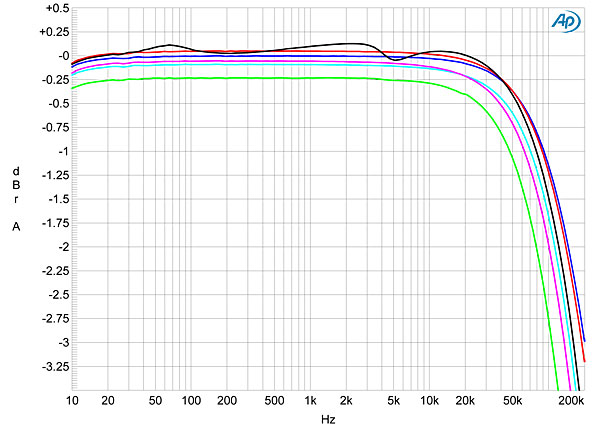
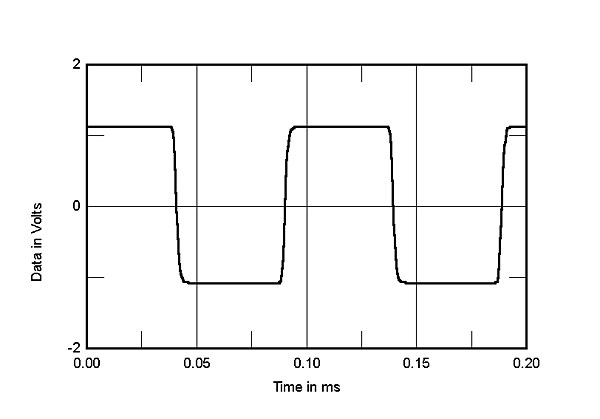
Channel separation was good, at >80dB below 2kHz. The wideband, unweighted signal/noise ratio, measured at the speaker terminals with the single-ended inputs shorted to ground but the volume control at its maximum, was an okay 71dB ref. 2.83V, this improving to 81dB when A-weighted. Spectral analysis of the Creek's output while it drove 1kHz at 1W into 8 ohms (fig.3) indicated that the highest-level spuriae were the even-order harmonics of the 60Hz AC frequency.
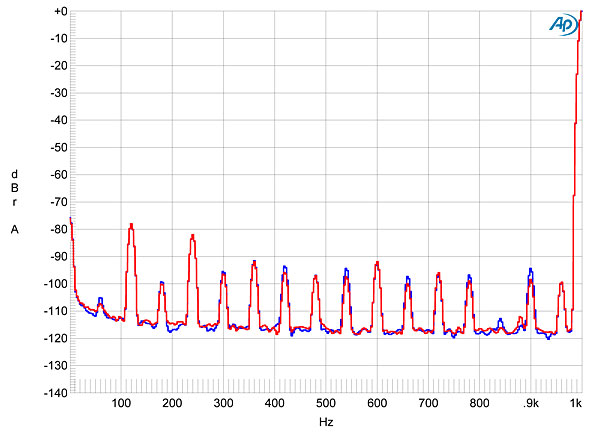
With both channels driven, the Evolution 100A met its specified power output at 1% THD+noise, delivering 113Wpc into 8 ohms (20.5dBW, fig.4) and 180Wpc into 4 ohms (19.5dBW, fig.5). The downward slope of the traces below a few tens of watts in figs. 4 and 5 suggests that actual distortion lies below the noise floor. However, note the kink in these traces at 33W into 8 ohms and at 50W into 4 ohms. These, presumably, are the voltage levels—respectively, 16.25V into 8 ohms and 14.15V into 4 ohms—at which the output stage's higher-voltage devices turn on. But the distortion at high power below clipping remains very low in absolute terms.
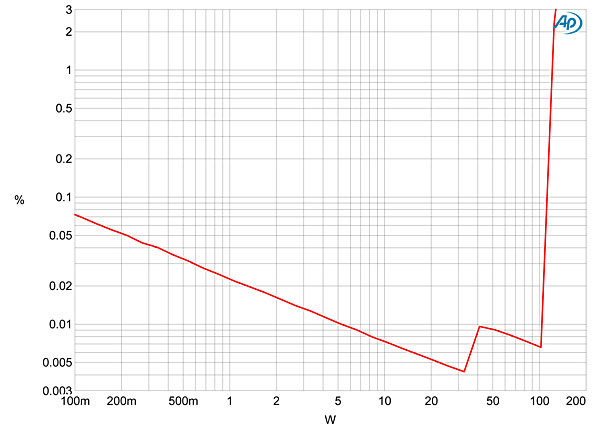
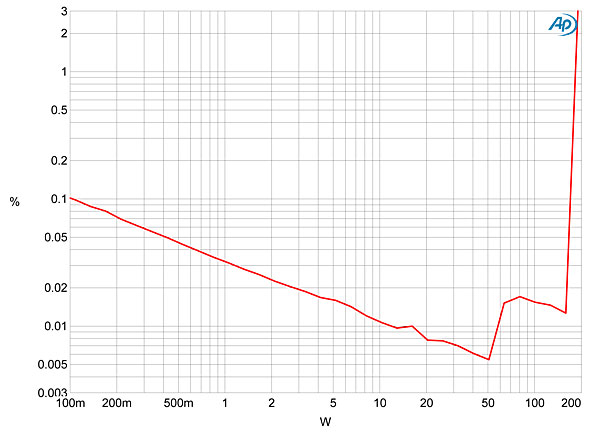
Fig.6 plots the percentage of THD+N against frequency at 12.65V, equivalent to 20W into 8 ohms and 40W into 4 ohms. The THD lies under the noise floor below 1kHz, and though it rises at higher frequencies, it is still low. Fig.7 shows the 100A's THD+N residual waveform at 10W into 8 ohms; though there is a suggestion of second-harmonic distortion, the waveform is primarily noise, even after averaging 32 captures. By contrast, the Evolution 50A's output stage appeared to be underbiased, with some crossover artifacts present in its residual waveform.
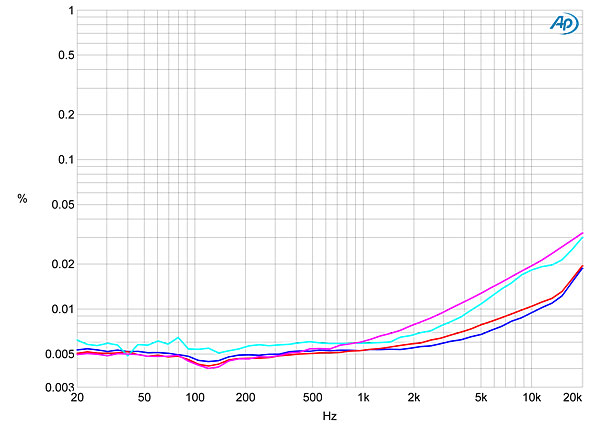
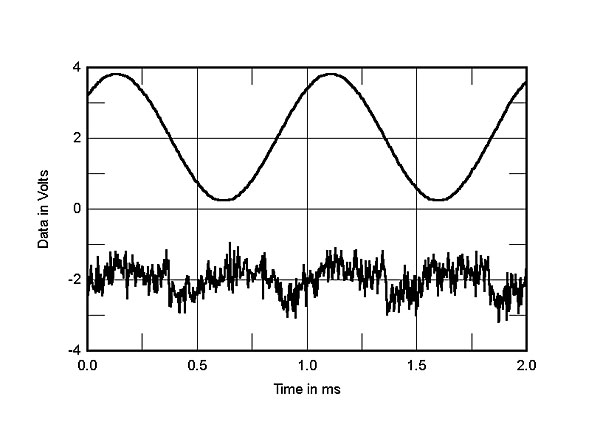
Repeating the residual waveform capture at 40W into 8 ohms with the 100A's higher-voltage output devices turned on gave the waveform shown in fig.8. The pairs of spikes bracketing each waveform peak are due to the higher-voltage devices switching on and off each cycle. However, the distortion level is still very low, at 0.009% vs 0.006%, so this behavior looks worse than it actually is. This was confirmed by spectral analysis of the Creek's output while it drove 50Hz at a level below the switching voltage (fig.9) and above it (fig.10). At 20Wpc into 8 ohms, the highest-level harmonic is the second at just –116dB, well below the level of the power-supply spuriae, while at 80Wpc into 8 ohms, though odd-order harmonics can now be seen, these still lie at a low level. Intermodulation distortion (fig.11) was also very low.
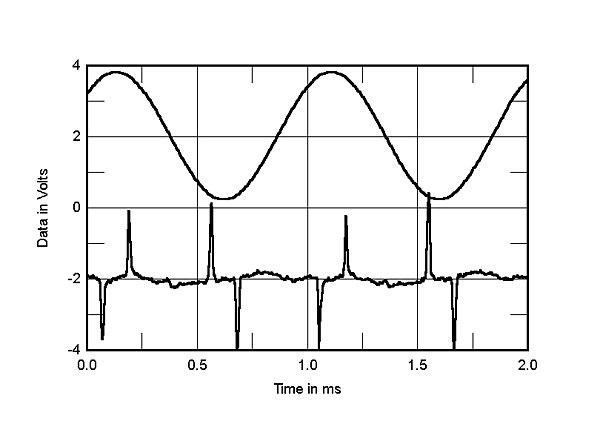
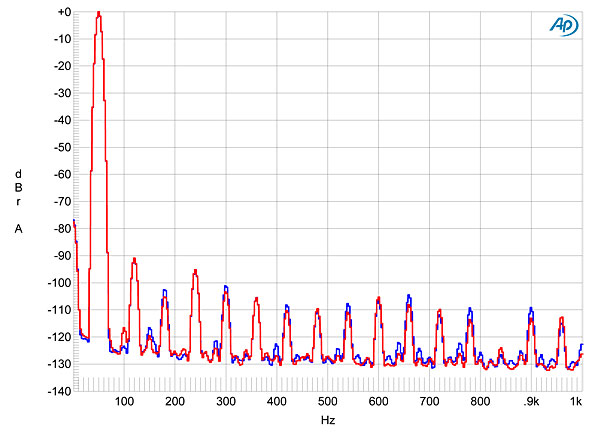
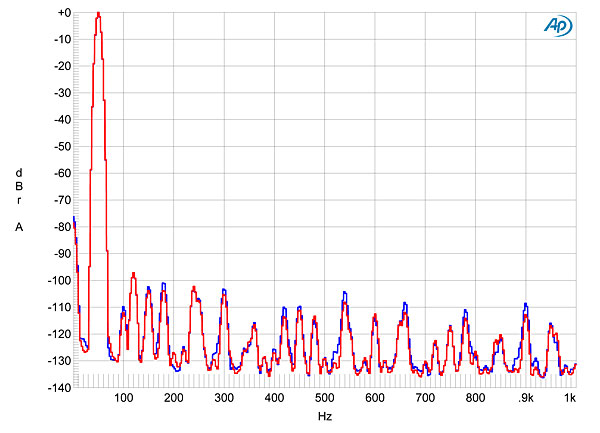
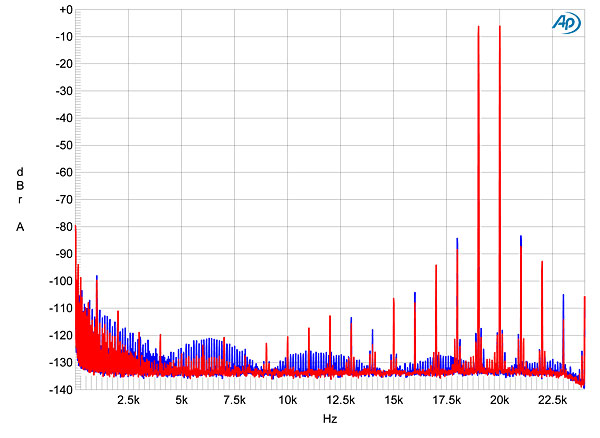
The Evolution 100A's Sequel Mk.2 phono module is based on vintage dual op-amp chips: one TL072 and two NE5532s. But measured at the preamp outputs, its performance was exemplary. The voltage gain was 40.1dB, and the Sequel's input impedance was 46k ohms at 20Hz and 1kHz, 42k ohms at 20kHz—all perfect for moving-magnet cartridges. The unweighted, wideband S/N ratio, ref. 1kHz at 5mV, was a good 61dB, this improving to 70.5dB when A-weighted. The phono module was non-inverting, and its RIAA equalization was superb (fig.12), with respect to both its accuracy and the match between channels.

The phono module also had superb overload margins, at close to 20dB across the audioband, and harmonic distortion was very low—with a 1kHz tone at 5mV, the highest-level harmonic was the third, at just –87dB. Intermodulation distortion (fig.13) was also very low.

Measuring the performance of Creek's Ruby digital-input module with the 100A's volume control set to its maximum, 1kHz data at –12dBFS gave rise to 754.3mV at the preamp outputs but a clipped output at the speaker terminals. Reducing the digital level to –20dBFS gave an output power of 14.2W, meaning that digital inputs should not be used with the volume control set above "–9dB" if the output stage is not to be driven into overload. Even so, I ran into the same problem mentioned earlier: With 192kHz-sampled data above 50kHz, the amplifier turned itself off even though the speaker outputs were inactive. This time, the output remained muted after I'd lowered the volume, and even after I'd turned the 100A off and on again. After some reflection, I used the remote control to turn off both sets of speakers; selecting Speakers A then brought the Creek back to life.
The TosLink inputs locked to all sample rates up through 192kHz, though the USB input was limited to 96kHz and below. Apple's USB Prober utility identified the 100A as "Evolution USB\000\000\000\000\000" from "Creek Audio," and revealed that the USB input operated in the isochronous adaptive mode. The Creek's impulse response with 44.1kHz data (fig.14) indicated that the digital reconstruction filter was a conventional time-symmetrical type, and 44.1kHz-sampled white noise at –4dBFS (fig.15, blue and cyan traces) rolled off rapidly above the Nyquist frequency (green vertical line). As a result, the image of a full-scale, 19.1kHz tone at 25kHz (44,100–19,100=25,000) was suppressed by 110dB (fig.15, red and magenta traces). The harmonics of the 19.1kHz all lie at or below –80dB (0.01%).
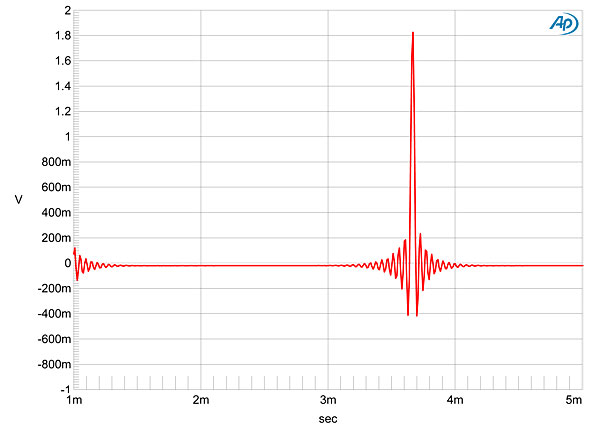
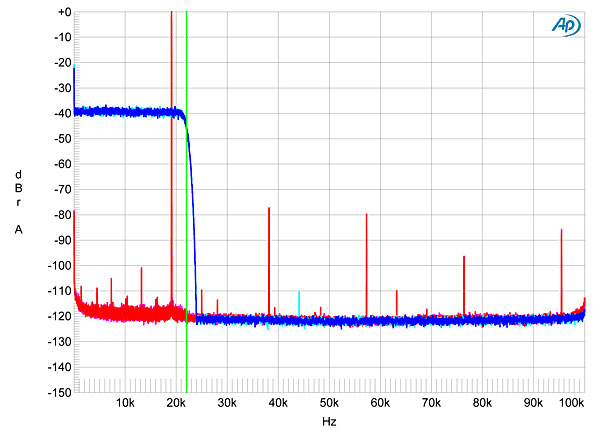
Fig.16 shows the Ruby module's frequency response with 44.1, 96, and 192kHz data. The audioband response is the same at all three sample rates. Though there is, as expected, a sharp rolloff above 20kHz with 44.1kHz data, the ultrasonic response with the two higher sample rates was not as extended as I had expected. With 192kHz data, the output was –3dB at 42kHz rather than at the anticipated 90kHz or so. Perhaps the DAC's digital filter at the higher sample rates is optimized for time-domain performance?
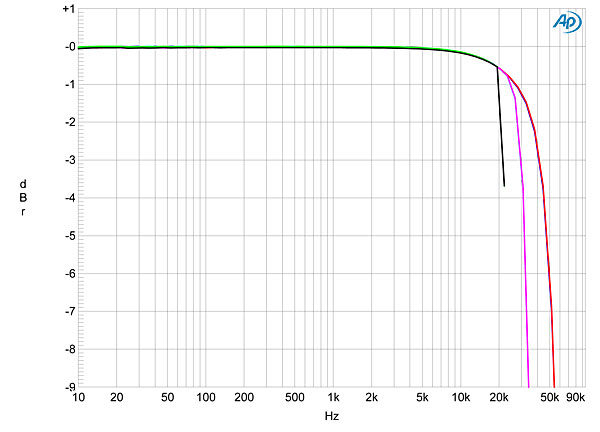
I test a DAC's resolution by feeding it first dithered 16-bit data representing a 1kHz tone at –90dBFS, then 24-bit dithered data representing the same signal. The results for the 100A are shown in fig.17. The drop in the noise floor with the increase in bit depth is around 16dB, suggesting resolution close to 19 bits, which is good. However, the low-level power-supply spuriae seen in earlier graphs are also evident here. Repeating this test with USB data gave the same result, confirming that the 100A's USB input correctly handles 24-bit data. With undithered 16-bit data at exactly –90.31dBFS, the result was three clearly defined DC voltage levels and a symmetrical waveform (fig.18), while with 24-bit undithered data the result was a good sinewave (fig.19).

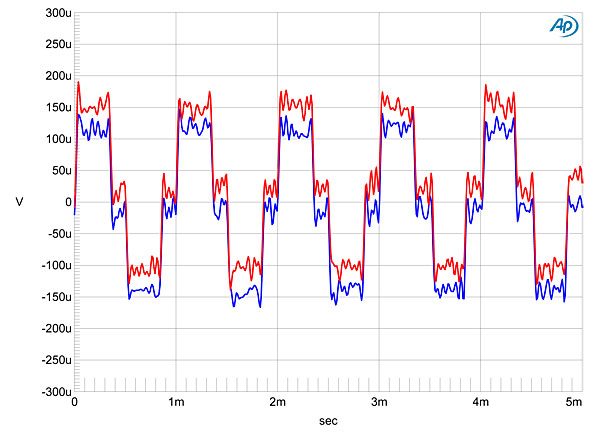
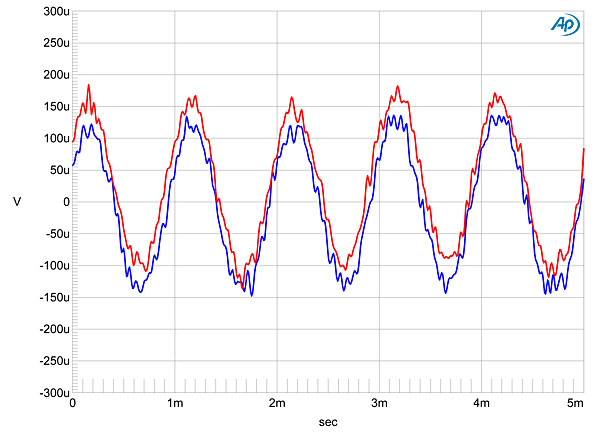
Finally, tested for rejection of jitter the TosLink and USB inputs behaved identically, with the odd-order harmonics of an LSB-level, 16-bit, low-frequency squarewave mostly at the correct level (fig.20, green line), and no jitter-related sidebands visible. However, some very low-level power-supply spuriae are visible in this graph.
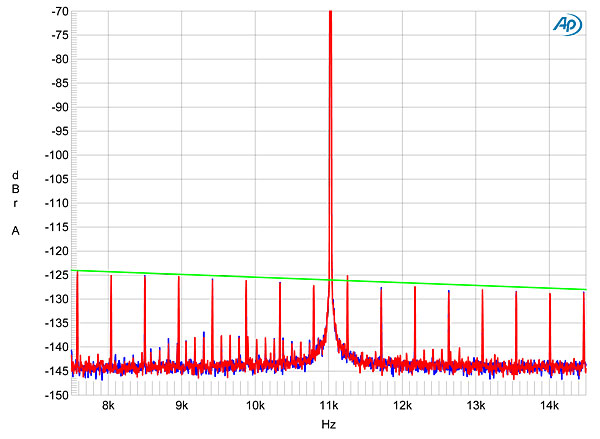
Assuming that the operational problems I encountered were specific to this well-traveled review sample, Creek's Evolution 100A integrated amplifier measured quite well. The dual-voltage-rail supply for the output stage works as advertised in increasing the output power compared with the Evolution 50A. I was particularly impressed by the $200 moving-magnet module, so it is a puzzle why HR felt it to be the 100A's weak point.—John Atkinson

Awesome! review- HR. These "little" integrated amps are something special indeed. A few years ago, I was struck by how well the 4330
made beautiful music w/ (my reference) Thiel CS 2.4 loudspeakers.

Like you, Herb, my taste used to be in expensive audio - high power amps, multi-driver speakers, etc.
A divorce - wherein my former wife got custody of that audio equipment - coupled with my changed financial situation forced me to re-examine my audio priorities.
I now use single-driver full-range speakers (Omega Super 3S) and a tube integrated amp (Dared 2A3C - 3.5 wpc) sourced by an old Nakamichi OMS-7 CD player.
I've had this system almost 2 years, and I wouldn't trade it for what I've ever had before. The sound is magical - and the whole system cost me less than $2500.

For me, the music comes first. As for the rest of the stuff, I just want it to get out of the way of the music; as simply and affordably as possible. I don't care to impress anyone with audio jewelry. Same goes for the music; it's mostly between the artist and me. (There's an old saying in the tailor business: "Is the man wearing the suit, or is the suit wearing the man?") As a result, my gear is pretty basic, but my music collection is rather large. (The walls are lined with records, which provide great acoustic room treatment.)
I was pretty happy with my:
deplinthed Dual 701 TT
Shure M97xE cart
Jico SAS stylus
Sony PS One as CD player
Creek 4330 SE integrated
Paradigm Studio 20 V3 speakers
entry level Wireworld cables...
...until I heard someone's full range system. I realized how much low end info I wasn't hearing at home. Space did not allow for large speakers so I got a pair of REL T5 subs at a good price.
Although my gear isn't even close to that of many of your readers, it does what I want and can afford. Every album sounds different, which I suspect means my gear is getting out of the way of the music and allowing the production values to come through. As a result, I've culled my music collection over the years. (The only upgrade I'd consider at this point is a more efficient pair of small speakers. Something which allows the music to flow easier, as in a more realistic midrange.)
I suspect that if I started buying high end equipment, I'd start thinking about the gear more than the music; focusing on gear integration, etc. And, not being the manager of a hedge fund, I'd worry more about gear value vs price. I don't want to go there. I'd rather just enjoy my music.

Anthony & Rick-
both of you guys have great systems. And yes, it is all about the (reproduction of) MUSIC!

You knew who made it, had the specs and the 'philosophy' behind it before you reviewed it.
These things should really be reviewed BLIND so the reviewer doesn't have any preconceived ideas on what to expect. Which he then listens for, and of course, finds.
Manufacturers don't like blind testing of course. Simply because it might well find that their $10,000 amp sounds no better than someone else's $3,000 one. That's the REAL reason, not all this "Blind tests are unrealistic because of listening fatigue, unfamiliar music, environment, etc" garbage. And by yourself of course, none of this 'panel' or 'scoring' nonsense. It is YOU that is going to buy it, or not.
I experienced this myself recently. I have a bias towards a well-known UK manufacturer (I'm in the UK). The local dealer had the one I was biased towards but had two others as well, both lower cost. I could not see them. I chose (blind) one of the lower cost ones. Had I been able to see them I would undoubtedly have walked out with the one I was biased towards.
I can PROVE what I say -
"Beowulf-like bleakness of the Anglo-Saxon landscape". You've not been here, have you? Beowulf is (1) imaginary, (2) set in Scandinavia, not England, where Creek amps are made :) The landscape is exactly the same today, unchanged. Not "bleak" at all. The UK is a 'cosy', manicured place, like a rich man's garden, and by comparison with the USA, always has been. Your pre-conceived ideas are getting in the way :)
PS: It's a very good amp, though not the one I chose. You really DON'T need to spend any more on an amplifier, integrated or separates. HiFi means 'accuracy'. If it has a flat frequency response over a wide range things such as PRAT, slew rate, 'impact' etc. are all a result of that frequency response. Given sufficient power to drive the speakers of course. And this one has enough power. You might find a $200,000 KSL Kondo Ongaku (a real one, not the British copy) or one of these expensive D'Agostini amps sounds more to your preference, or 'magical', but if it sounds different from the Creek it ISN'T HiFi as it isn't accurate. (The more you pay the more amplfiers should sound the same. If they don't something is seriously wrong. 'Budget' amplifiers may have excuses for inaccuracy, costly ones have not. And there is only one accuracy - something is either accurate or it isn't. Huge bass? To quote 'Jud', an audio enthusiast and a wise man "No one ever came out of an opera or a classical concert saying 'Wasn't the bass good?'")

You are totally wrong, my friend. Sounds like you're trying to rationalize that you made the best purchase.
Haven't had a good laugh all week, thanks!
(And btw, the Ongaku's retail price is about $90K and no one pays retail...)
Quote:
You really DON'T need to spend any more on an amplifier, integrated or separates. HiFi means 'accuracy'. If it has a flat frequency response over a wide range things such as PRAT, slew rate, 'impact' etc. are all a result of that frequency response. Given sufficient power to drive the speakers of course. And this one has enough power. You might find a $200,000 KSL Kondo Ongaku (a real one, not the British copy) or one of these expensive D'Agostini amps sounds more to your preference, or 'magical', but if it sounds different from the Creek it ISN'T HiFi as it isn't accurate. (The more you pay the more amplfiers should sound the same. If they don't something is seriously wrong.

"High Fidelity" means "Accuracy" by definition. Look it up.
And obviously if a box does not have a FLAT freguency response over at least the AUDIBLE bandwidth it can't be accurate so isn't HiFi.
In fact you need more than the audible bandwidth to give a good rise time as rise time is a function of frequency response - read a school physics book. So called 'Pace, Rhythm, And Timing' will automatically follow - it CAN'T do anything else.
Offhand I would go for 50KHz minimum.
It's not meant to br 'nice' or 'what you like'. It's meant to be ACCURATE. If you don't like the music go buy a more accurate recording. All this 'subjective' garbage is just typical American nonsense marketing.
If you want it 'subjective' go buy a $500 WalMart complete stereo and be happy - you don't need to spend $100,000 plus if you want it inaccurate, do you?
Justify? No. Only stupid people buy something first and justify it afterwards. Sensible people like me do the justification first.